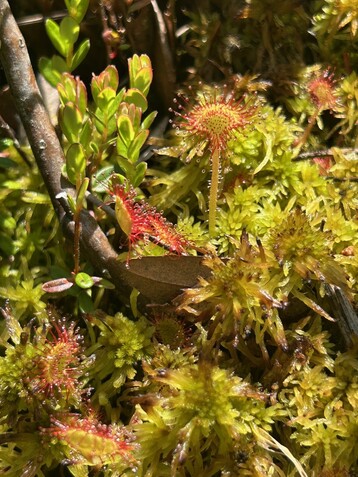Current Nature: The Blanket Beneath Your Feet
By Lucas Leasure, Linda Loring Nature Foundation •

As we sit inside during the rainy days of spring, warm coffee in hand to beat the chill and stay dry, Sphagnum moss thrives. Formed by the last glacier’s retreat, Nantucket island is home to numerous bog and wetland ecosystems, and Sphagnum is a major contributor to these unique and highly valued environments.
Nantucket is home to historic cranberry bogs, which have played an important role in the island’s economy before industrialization. Capable of holding twenty to forty times its weight in water, Sphagnum acts as the foundation for these important ecosystems, creating a blanket of moss that serves as the ground of the bog. Looking at an individual stem of Sphagnum, you’ll find the head, known as the capitulum, that is held above water. However, only a few inches of the top of the stem are alive. The rest of the stem is composed of dead cells, capable of holding immense amounts of water and reaching meters deep into the bog. Although this means the majority of the Sphagnum matter is dead, the process of decay of Sphagnum
is incredibly slow, with layers of dead cells accumulating and retaining water for centuries.

Creating these acidic, waterlogged systems, Sphagnum fills the spaces in the soil that would otherwise hold air. This lack of air leads to an anaerobic environment that the majority of plant roots are not able to tolerate. Importantly, this impedes the establishment of trees, ensuring that the bog stays open and sunny. Examples of plant species that have adapted to tolerate the anaerobic and acidic conditions of the bog are bayberry, leatherleaf, and cranberry vines.
If you’ve ever seen wetland water, you may have noticed that it often looks brown, like root beer. Unfortunately, it doesn’t taste nearly as sweet. Sphagnum’s slow decay results in the release of humic and tannic acids, leading to the brown color often seen in wetland waters. Furthermore, without decomposition occurring at a regular pace, Sphagnum becomes nitrogen-deficient. Creating this low-nutrient habitat, Sphagnum supports the presence of insectivorous plants, such as sundews, that feed on the abundant insects found throughout the bog ecosystem.

The inquiry of Sphagnum that I find most interesting is how fauna and humans have utilized the impressive absorption capabilities of this plant throughout history. Indigenous people had a variety of uses for Sphagnum, ranging from menstrual sanitary napkins to disposable diapers for their children. Sphagnum was especially well suited for both of these tasks due to its antimicrobial properties, helping Indigenous parents avoid diaper rash.
Additionally, it is common for birds to utilize Sphagnum when creating their nests, adding cushioning and durability for their young. Humans have historically used Sphagnum in a similar capacity, utilizing the moss in cradles for infants. It’s clear that in a time before foam mattress toppers and silk pillow cases, Sphagnum was the go-to item for comfort.
Outside of bogs, Sphagnum can be found in many other wetland types throughout the island, such as swamps and vernal pools, providing habitat for aquatic organisms and reducing runoff. I hope that during your future outside adventures, you can spend some extra time looking closely at the soft moss that grows small but resilient beneath your feet.
Stay tuned for more editions of Current Nature, a bi-weekly column featuring seasonal topics, natural history information, and advice on the outdoors from the staff at the Linda Loring Nature Foundation.